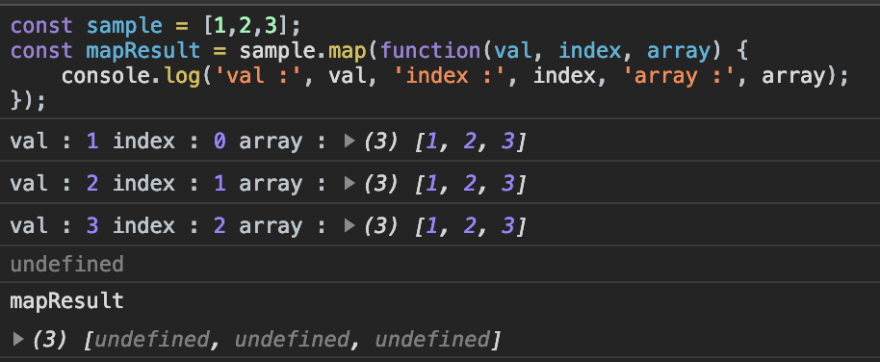If you know howArray.map() works, you can jump here directly.
What is Array.map in javascript?
A map is a built-in function of Arrays in javascript which helps us iterate over each individual element of the array and returns a brand new array.
First let us understand how map behaves,
For Example:
const sample = [1,2,3];
const mapResult = sample.map(function(val, index, array) {
console.log('val :', val, 'index :', index, 'array :', array);
return (val * 2);
});
The output of the above snippet will be:

So, we can conclude that, for each value of the array the function gets executed. And the function has access to 3 arguments:
- The current element that is processed
- Current element's index
- Entire Array
We are returningval*2 on every iteration and that gets stored inmapResult.
So,mapResult has [2,4,6] in it and this wont modify the original arraysample.
Thus, whatever that is returned by map during each iteration, will get stored inside a brand new array and the original array remains untouched.
Note: If nothing is returned from the function then
undefinedgets stored in the output array.And this array's length will be same as that of the array on which map is done.
If we did not return anything in our previous example then,
map will always return an array.So we don't have to write an explicit return from an Array.map function which is why we use map most of the times to iterate through lists in React.
Lets create our own map method[mymap]
Step 1:
- We will create a new method[mymap] which allows us to use
Array.mymap() - In order to use Array.mymap() we have to have
mymap()'s definition in Array.prototype.
Array.prototype.mymap = function(){
}
Now we will be able to run[1,2,3].mymap(); which will returnundefined.
Step 2:
-
mapis called with function as an argument inside it. (eg:[1,2].map(function(val, index, arr){})). So, ourmymapfunction should accept a function as an argument. - The function in the argument should be called for each value in the array with 3 arguments:
- The current element
- Current element's index
- Entire Array
-
thisrefers to the array on whichmymapis done.thisis the array itself.
Array.prototype.mymap = function(callback) {
for (let index = 0; index < this.length; index++) {
callback(this[index], index, this);
}
}
Step 3:
- Finally, we output the result to a new array and return them.
Array.prototype.mymap = function(callback) {
const resultArray = [];
for (let index = 0; index < this.length; index++) {
resultArray.push(callback(this[index], index, this));
}
return resultArray;
}
Output:
Thats it :) we have implemented our own map method.
Share if it helped you :)
Next step: Try using similar approach and create a custom map for objects.










Top comments (10)
@diliptwit291 The above implementation fails for
Gives, different results from
mapArray.prototype.myMap= function (callback) {
let result = this;
for (let index = 0; index < this.length; index++) {
if (this[index] === undefined) {
break;
}
result[index] = callback(this[index], index, this);
}
return result;
};
here is i've wrote with context passing
Array.prototype.myMap = function(cb, thisArg) {
const newArray = [];
const that = thisArg || this;
const thatLength = that.length;
};
Another solution here.
It can be argued why the use of
for ( of )instead of the classicfor.I'm interested on the topic too. Share your thoughts
Interesting, altough I have a problem where this case not function because others class, use the element 'this' and result in error. I trying resolve it, when I do, I´ll share the results. I commented this in case someone know how to do. Help is welcome.
Nice
I have a question, what if you use an arrow operator. It uses global window as this then, why so?
That's due to the property of the arrow function where it binds the Lexical this as its own this. That is the reason why we not use arrow function here
Good